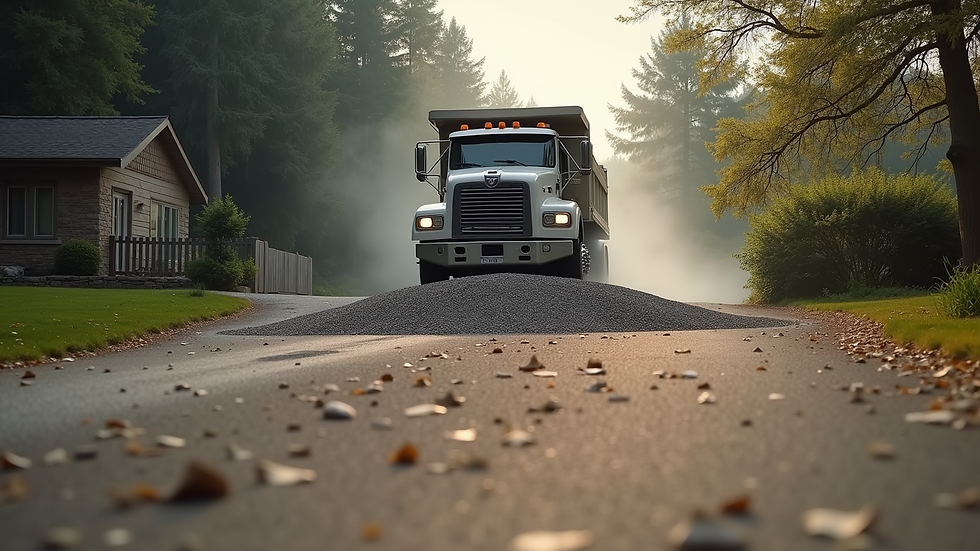Mastering the Process of Gravel Road Installation
- dimtzservicesllc
- Sep 15
- 4 min read
Building a gravel road is a practical way to improve access and durability on your property. It is cost-effective and requires less maintenance than paved roads. I will guide you through the key gravel road techniques that ensure a strong, long-lasting road. These steps are straightforward and designed for anyone ready to take on the project.
Understanding Gravel Road Techniques
The first step in any gravel road project is understanding the right techniques. Gravel roads need a solid base, proper drainage, and the right gravel mix. Without these, the road will quickly degrade.
Start by clearing the area of vegetation and debris. Next, grade the surface to create a slight crown in the middle. This crown helps water run off the road instead of pooling on it. Proper drainage is critical to prevent erosion and potholes.
Use a mix of gravel sizes. Larger stones form a stable base, while smaller gravel fills gaps and compacts well. This layering technique locks the gravel in place and reduces movement.

Preparing the Site for Gravel Road Installation
Site preparation is the foundation of a successful gravel road. I always start by marking the road path clearly. This helps avoid surprises during construction.
Next, remove all topsoil and organic material. These materials do not support weight and will cause the road to fail. Excavate to a depth of 6 to 12 inches depending on soil conditions and expected traffic.
After excavation, compact the soil using a roller or plate compactor. Compaction prevents settling and keeps the road stable. If the soil is very soft, consider adding a layer of crushed rock or geotextile fabric for extra support.
Drainage ditches should be dug alongside the road. These ditches channel water away and protect the road edges. Make sure the ditches slope away from the road and lead to a safe drainage point.

Choosing the Right Gravel for Your Road
Selecting the right gravel is crucial. Not all gravel is the same. I recommend using crushed stone with angular edges. Angular gravel locks together better than rounded gravel, which tends to shift.
The base layer should be made of larger stones, about 1 to 2 inches in diameter. This layer provides strength and drainage. On top, add a layer of smaller gravel, around 3/8 inch, to fill gaps and create a smooth surface.
Avoid using pea gravel or river rock. These are rounded and do not compact well. They can cause the road surface to become loose and uneven.
For the best results, source gravel locally. Local gravel is often more cost-effective and suited to the regional climate and soil.
Step-by-Step Gravel Road Installation Process
Now that the site is ready and gravel is selected, it is time to install the road. Follow these steps for a durable gravel road:
Lay the base layer: Spread the large gravel evenly across the roadbed. Aim for a depth of 4 to 6 inches.
Compact the base: Use a roller or plate compactor to press the gravel firmly into place.
Add the top layer: Spread the smaller gravel over the base. This layer should be 2 to 3 inches thick.
Compact the top layer: Compact again to lock the gravel together.
Shape the road: Use a grader or rake to maintain the crown and smooth the surface.
Install drainage features: Place culverts or drainage pipes where needed to manage water flow.
Regular maintenance is key. After heavy rains or use, regrade the road and add gravel as needed to fill low spots.

Maintaining Your Gravel Road for Longevity
Maintenance keeps your gravel road in good shape. I recommend inspecting the road after storms or heavy use. Look for potholes, washboarding, or erosion.
Fill potholes promptly with fresh gravel. Compact the patch to prevent it from breaking down again. Washboarding, the rippled surface that forms from traffic, can be smoothed out by grading.
Keep drainage ditches clear of debris. Blocked ditches cause water to pool on the road, leading to damage. If you notice erosion along the edges, add gravel or soil to stabilize the area.
Seasonal maintenance is also important. In dry weather, watering the road can reduce dust and help gravel settle. In wet seasons, ensure drainage systems are functioning well.
Why Choose Professional Gravel Road Installation Services
While DIY gravel road projects are possible, professional services offer expertise and equipment that save time and improve quality. Professionals understand local soil conditions and use the best gravel road techniques to build roads that last.
If you want a reliable, well-built road, consider hiring experts. They handle everything from site preparation to final grading. This reduces the risk of costly repairs later.
For those in the DFW area, I recommend checking out gravel road installation services by DIMTZ Services LLC. They specialize in quality gravel work and have a strong reputation for safe, dependable projects.
Taking the First Step Toward a Durable Gravel Road
Building a gravel road is a smart investment. It improves access, reduces mud, and adds value to your property. By mastering these gravel road techniques, you can ensure your road stands up to weather and traffic.
Start with proper planning and site preparation. Choose the right gravel and follow the installation steps carefully. Maintain your road regularly to keep it in top condition.
With the right approach, your gravel road will serve you well for years to come. Take action today and create a road that meets your needs and lasts.



Comments